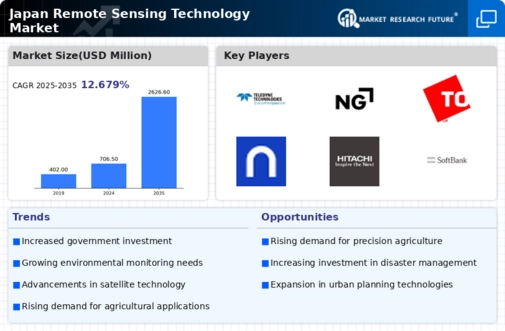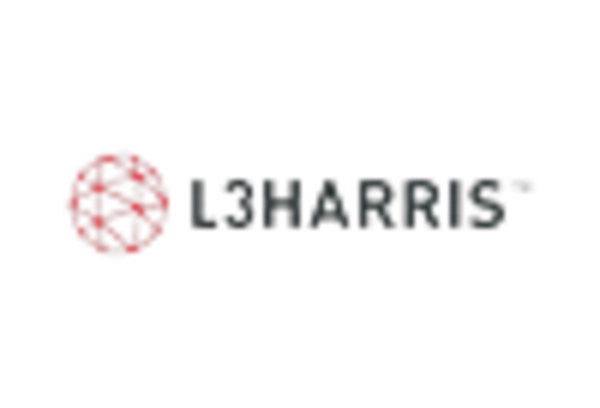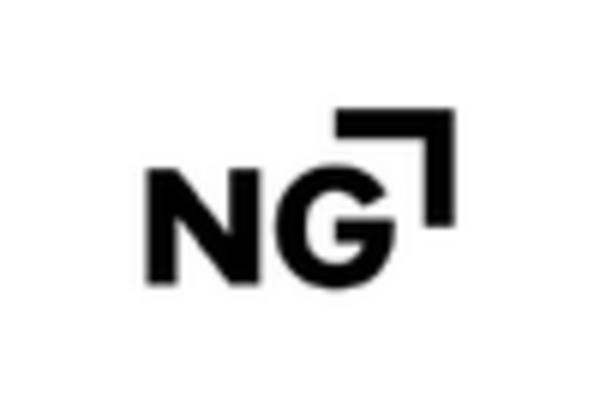Environmental Monitoring and Compliance
The increasing emphasis on environmental protection in Japan is a crucial driver for the remote sensing-technology market. Regulatory bodies are utilizing remote sensing technologies to monitor air and water quality, deforestation, and land use changes. The market is likely to expand as industries face stricter environmental regulations and compliance requirements. For instance, the Japanese government has set ambitious targets for reducing greenhouse gas emissions, which necessitates accurate monitoring of environmental parameters. Investments in remote sensing technologies for environmental monitoring are projected to grow by 15% annually, reflecting the market's potential to support sustainable practices and regulatory compliance.
Urbanization and Smart City Initiatives
Japan's rapid urbanization is a key driver for the remote sensing-technology market. As cities expand, there is a pressing need for effective urban planning and management. Remote sensing technologies provide critical data for monitoring urban growth, infrastructure development, and environmental changes. The Japanese government has initiated several smart city projects, which rely on remote sensing data to enhance urban living conditions. Investments in these initiatives are projected to reach $2 billion by 2026, further stimulating the remote sensing-technology market. The ability to analyze urban dynamics through satellite imagery and geospatial data is likely to facilitate better decision-making and resource allocation in urban environments.
Growing Demand for Precision Agriculture
In Japan, the agricultural sector is increasingly adopting remote sensing technologies to enhance productivity and sustainability. The remote sensing-technology market is benefiting from the growing need for precision agriculture, which utilizes satellite imagery and data analytics to optimize crop management. Farmers are leveraging these technologies to monitor crop health, assess soil conditions, and manage resources more effectively. Reports indicate that the adoption of precision agriculture techniques could lead to a 20% increase in crop yields. As Japan aims to improve food security and reduce environmental impact, the remote sensing-technology market is poised for significant growth, driven by the agricultural sector's evolving needs.
Disaster Management and Mitigation Efforts
Japan is prone to natural disasters, making effective disaster management a priority. The remote sensing-technology market is significantly influenced by the need for timely and accurate data. This data is essential to assess disaster impacts and coordinate response efforts. Technologies such as satellite imagery and aerial surveys are essential for monitoring events like earthquakes, tsunamis, and floods. The Japanese government has invested heavily in disaster preparedness, with funding exceeding $1 billion annually for research and technology development. This focus on disaster management is expected to drive the remote sensing-technology market, as agencies seek to enhance their capabilities in risk assessment and recovery planning.
Technological Advancements in Satellite Systems
In Japan, the remote sensing-technology market is experiencing a surge due to rapid advancements in satellite technology. Enhanced imaging capabilities, such as higher resolution and improved spectral sensitivity, are driving demand across various sectors. For instance, the introduction of small satellites has reduced costs and increased accessibility for businesses and government agencies. The Japanese government has allocated approximately $1.5 billion for satellite development and deployment, which is expected to bolster the remote sensing-technology market. Furthermore, the integration of advanced sensors and communication technologies is likely to enhance data collection and processing efficiency, thereby expanding the market's potential applications in agriculture, urban planning, and disaster management.

















Leave a Comment